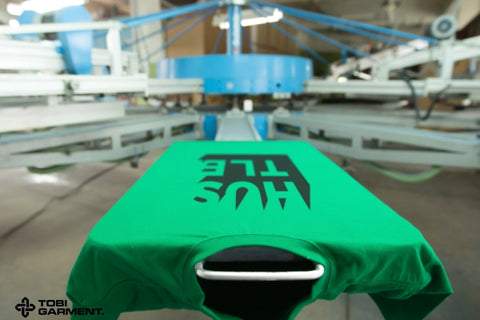
Screen printing is a versatile printing technique that allows you to transfer designs onto fabric using a mesh screen, ink, and a squeegee. This method is popular for its durability and vibrant colors, making it ideal for various fabrics, including cotton, polyester, and even lycra spandex fabric. As I share my knowledge and experiences, I aim to empower you to create stunning printed garments that reflect your unique style and vision.
Let’s dive into the world of screen printing and explore the essential steps to get started!
Essential Equipment for DIY Screen Printing
Essential Equipments
Before you begin your screen printing adventure, it’s crucial to gather the right tools and materials. Here’s a list of essential equipment you’ll need:
- Screen Printing Frame: This frame holds the mesh screen taut and is available in various sizes.
- Mesh Screen: The mesh screen is where your design will be printed. Choose a mesh count suitable for your ink type and design detail.
- Squeegee: A squeegee is used to push ink through the mesh screen onto the fabric.
- Ink: Select high-quality screen printing ink that is compatible with your fabric type. Water-based inks are great for cotton, while plastisol inks work well on synthetic fabrics like polyester and spandex clothing.
- Emulsion and Sensitizer: If you’re creating your own screens, you’ll need emulsion to coat the screen and a sensitizer to make it light-sensitive.
- Light Source: A light source is necessary for exposing your design onto the emulsion-coated screen.
- Garments: Choose the fabric you want to print on. Popular choices include cotton, polyester, and blends like lycra polyester spandex.
Choosing the Right Screen
Selecting the right screen is crucial for achieving high-quality prints. The mesh count of the screen determines how much ink passes through and affects the detail of your design.
- Low Mesh Count (40-60): Ideal for bold designs and thicker inks. Great for printing on fabrics like cotton.
- Medium Mesh Count (80-120): Suitable for most designs and inks, providing a good balance between detail and ink flow.
- High Mesh Count (160-230): Best for fine details and intricate designs, especially when using water-based inks.
Read more: Discharge Screen Printing: Your Guide to Creating Stunning Designs
Selecting High-Quality Ink
The type of ink you choose can significantly impact the final result. Here are some popular options:
- Plastisol Ink: Durable and versatile, it works well on various fabrics, including lycra and spandex. It requires heat to cure properly.
- Water-Based Ink: Eco-friendly and soft to the touch, it’s perfect for natural fibers like cotton but may not adhere well to synthetic fabrics without a proper pre-treatment.
- Discharge Ink: This ink removes the dye from the fabric, leaving a soft print. It works best on dark fabrics and requires a specific curing process.
Gathering Other Necessary Supplies
In addition to the main equipment, here are some other supplies you may need:
- Tape: Use tape to secure your screen and prevent ink leakage.
- Cleaning Supplies: Keep your workspace clean with rags, water, and cleaning solutions for screens and squeegees.
- Heat Source: A heat gun or flash dryer is essential for curing your prints, especially when using plastisol ink.
Creating Your First Stencil
Creating a stencil is a vital step in the screen printing process. Here’s how to do it effectively:
Understanding Stencil Types
There are two main types of stencils you can create:
- Photo Emulsion Stencils: These are created by coating a screen with emulsion, exposing it to light with your design, and then washing it out. This method allows for intricate designs.
- Vinyl Stencils: These are cut from vinyl material and adhered directly to the screen. They are great for simple designs and quick setups.
Using a Stencil Maker
If you opt for photo emulsion, you can use a stencil maker to create your design digitally. Here’s how:
- Design Your Artwork: Use graphic design software to create your design. Ensure it’s in black and white for the best results.
- Print the Design: Print your design onto a transparency film. This will be used to expose the emulsion.
- Coat the Screen: In a dark room, coat your screen with emulsion evenly. Allow it to dry in a dark place.
- Expose the Screen: Place the transparency on the screen and expose it to a light source for the recommended time.
- Wash Out the Screen: After exposure, wash the screen with water to reveal your design.
Hand-Cutting a Stencil
For vinyl stencils, follow these steps:
- Design Your Artwork: Create your design using vinyl cutting software.
- Cut the Vinyl: Use a vinyl cutter to cut out your design.
- Weed the Design: Remove the excess vinyl, leaving only your design.
- Transfer the Stencil: Use transfer tape to apply the stencil to your screen.
Read more: Screen Printing Hoodies: A Step-by-Step Tutorial for DIY Enthusiasts
Preparing Your Garment for Printing
Before printing, it’s essential to prepare your garment properly. Here’s how:
Pre-washing the Garment
Pre-washing your garment removes any chemicals or residues that could interfere with ink adhesion. Here’s how to do it:
- Wash the Fabric: Use a gentle detergent and cold water to wash the garment.
- Dry Completely: Ensure the garment is completely dry before printing.
Setting Up Your Workspace
A clean and organized workspace is crucial for successful screen printing. Here are some tips:
- Choose a Flat Surface: Use a sturdy table or workbench to set up your printing station.
- Keep Supplies Handy: Organize your inks, screens, and tools for easy access during the printing process.
- Ensure Good Lighting: Proper lighting helps you see details and ensures accurate placements.
Applying a Pre-wash Treatment (if necessary)
If you’re working with synthetic fabrics like lycra spandex fabric, consider applying a pre-wash treatment to enhance ink adhesion. Follow the manufacturer’s instructions for the best results.
Read more: Building Your Own DIY Dry Box: A Step-by-Step Guide
The Screen Printing Process
Now that you’re prepared, let’s dive into the screen printing process step-by-step.
Positioning the Stencil
- Align the Screen: Place the screen on your garment, ensuring it’s centered and straight.
- Secure the Screen: Use tape to secure the screen in place to prevent movement during printing.
Applying Ink
- Prepare the Ink: Stir your ink thoroughly to ensure even consistency.
- Pour the Ink: Pour a line of ink along the top edge of the screen.
Squeegeeing the Ink
- Angle the Squeegee: Hold the squeegee at a 45-degree angle.
- Apply Pressure: Press down firmly and pull the squeegee across the screen, pushing the ink through the mesh onto the fabric.
- Repeat as Necessary: Depending on your design, you may need to make multiple passes to achieve full coverage.
Flash Curing the Print
- Use a Flash Dryer: After printing, use a flash dryer to partially cure the ink before applying additional colors or layers.
- Check for Curing: Ensure the ink is dry to the touch before proceeding.
Tips for Successful Screen Printing
Here are some valuable tips to ensure your screen printing experience is successful:
Cleaning Your Equipment
After each printing session, clean your screens and squeegees immediately to prevent ink from drying and clogging the mesh. Use water and a gentle scrub to remove ink residue.
Storing Your Materials
Store your inks and screens in a cool, dry place to maintain their quality. Ensure that screens are stored flat to avoid warping.
Troubleshooting Common Issues
- Ink Not Adhering: Ensure your garment is pre-washed and dry. Check your ink compatibility with the fabric.
- Blurry Prints: This may be due to improper squeegee technique or a clogged screen. Clean your screen thoroughly and practice your technique.
- Uneven Coverage: Ensure even pressure is applied when squeegeeing. Adjust your technique as necessary.
Read more: Easily Convert Any Color to Pantone Color - Precise Color Matching
Conclusion
Screen printing is a rewarding and creative process that allows you to express your unique style through custom garments. By following the steps outlined in this guide, you can confidently embark on your screen printing journey, creating stunning designs that resonate with your vision.
FAQ
1. Can you screen print on polyester?
Yes, you can screen print on polyester using plastisol inks, which adhere well to synthetic fabrics.
2. Is spandex stretchy?
Yes, spandex is known for its exceptional stretchability, making it a popular choice for activewear and fitted garments.
3. How do I clean my screen printing equipment?
Clean your screens and squeegees immediately after use with water and a gentle scrub to prevent ink from drying.
4. Can you dye lycra?
Yes, you can dye lycra, but it requires specific dyes suitable for synthetic fibers.
Read more related posts from Tobi Garment:



